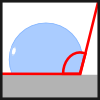by A.E. Charola and F. Wittmann
- Silanes: Original generic name for the family of compounds resulting from silicon and hydrogen links. By extension the name is applied to silicon compounds that have one or two bonds to carbon atoms.
For these compounds, it refers to the monomer, i.e., a single Si atom linked to one or two alkyl groups (methyl = -CH3; ethyl = -C2H5; etc.) and to three or two alkoxy groups (methoxy = -OCH3); ethoxy = -O C2H5; etc.). The Si-C bond is not easily broken characterizing the properties of these compounds.
- Siloxanes: The name refers to the -Si-O-Si- bond. For example, the compound (CH3)3-Si-O-Si-(CH3)3 is called hexamethyldisiloxane.
- Oligosiloxanes: Oligomeric siloxanes are smaller polymers, such as dimers or trimers. In general is it accepted that they range between 3 to 8 repeating units, though it has to be remembered that during polymerization a range of polymers are formed, so that these numbers might be considered a "rule of thumb" for nomenclature.
- Polysiloxanes: These are macromolecules of a higher number of repeating units, in general above 9 but always remembering that this is only median value for the range of polymers that form.
- Silicone resins: Silicone resins are highly branched siloxanes of higher molecular weight.
- Stearates: These are salts that result from the saponification reaction of the stearic acid (a long chain fatty acid frequently found in natural fats) with an alkali, alkaline earth or other metal hydroxide. As water repellents the stereates of aluminium, zinc and other metals are used. They have a polar head and a long non-polar tail and are therefore also surfactants.
- Traditional water repellents:
Historically, oils, such as linseed oil; fats, such as tallow (mutton fat); and, bitumen have been used as hydrophobization agents.
Formulation types
- Solution: A solution is formed when one substance is ionically or molecularly dissolved in another. Example, salt or sugar in water, respectively.
- Emulsion: A liquid dispersed as a colloid (1 to 100 nm) in another liquid, for example, milk. When the colloids are only a few ten nanometers (10-50 nm) in size, it is called a microemulsion. When the colloid is over 1000 nm (> 1 ?m) it is called a macroemulsion.
- Dispersion: Comprises two phases, one finely divided often in the colloidal size range, dispersed throughout a continuous phase most often a liquid (water or nonaqueous).
- Suspension: A substance dispersed microscopically in another substance (solid in a liquid = sol; liquid in a liquid = emulsion; gas in a liquid = foam; solid or liquid in a gas = aerosol).
- Cream: A highly concentrated microemulsion or dispersion of polar and non-polar components to which thickening agnest may be added to provide them with tixotropic properties so that it has a consistency capable of retaining its shape over time.
- Gel:Nonfluid colloidal network or polymer network that is expanded throughout its whole volume by a fluid. If the network is formed by a polymer it is called a polymer gel. If water is the swelling component it is referred to as a hydrogel. If the gel dries out, it is referred to as a xerogel.
